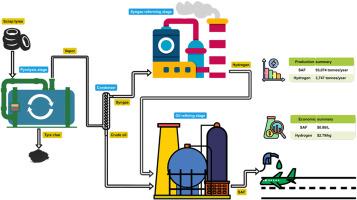从废轮胎到喷气燃料:循环经济框架下的氢整合和经济可行性
IF 8.3
2区 工程技术
Q1 CHEMISTRY, PHYSICAL
引用次数: 0
摘要
本研究提出了一种在循环经济框架内利用废旧轮胎生产可持续航空燃料的创新方法。热解过程将废轮胎分解成炭、油和气产品。然后,热解油通过催化裂化、烷基化和加氢处理等工艺精制成喷气燃料。同时,热解合成气作为蒸汽重整制氢的原料。因此,据计算,每年可从202,200吨废轮胎生产约93,074.4吨可持续航空燃料。此外,热解合成气每年可生产3796.26吨氢气。最后,航空燃料和氢的估计最低销售价格分别为0.86美元/升和2.79美元/公斤。先前的研究表明,用于精炼热解油的氢来自外部来源。然而,这项研究表明,精炼过程所需的所有氢气都可以从热解合成气本身获得。据我们所知,这种方法在以前的文献中还没有被采用。所建议的模式不仅能够以低成本生产可持续航空燃料,而且有助于可持续的废物管理做法。本文章由计算机程序翻译,如有差异,请以英文原文为准。

From scrap tyres to jet fuel: Hydrogen integration and economic feasibility within a circular economy framework
This study presents an innovative approach to producing sustainable aviation fuel from scrap tyres within the framework of the circular economy. The pyrolysis process decomposes scrap tyres into char, oil, and gas products. The pyrolysis oil is then refined into jet fuel through catalytic cracking, alkylation, and hydrotreating processes. Meanwhile, the pyrolysis syngas is used as feedstock for hydrogen production via the steam reforming process. As a result, it was calculated that approximately 93,074.4 tonnes/year of sustainable aviation fuel could be produced from 202,200 tonnes of scrap tyres per year. Additionally, 3796.26 tonnes of hydrogen could be produced annually from pyrolysis syngas. Finally, the estimated minimum selling prices of jet fuel and hydrogen were $0.86/L and $2.79/kg, respectively. Previous research has shown that the hydrogen used to refine pyrolysis oil comes from external sources. However, this study shows that all the hydrogen needed for the refining processes can be obtained from the pyrolysis syngas itself. To the best of our knowledge, this approach has not been adopted before in the literature. The proposed model not only enables low-cost production of sustainable aviation fuel but also contributes to sustainable waste management practices.
求助全文
通过发布文献求助,成功后即可免费获取论文全文。
去求助
来源期刊

International Journal of Hydrogen Energy
工程技术-环境科学
CiteScore
13.50
自引率
25.00%
发文量
3502
审稿时长
60 days
期刊介绍:
The objective of the International Journal of Hydrogen Energy is to facilitate the exchange of new ideas, technological advancements, and research findings in the field of Hydrogen Energy among scientists and engineers worldwide. This journal showcases original research, both analytical and experimental, covering various aspects of Hydrogen Energy. These include production, storage, transmission, utilization, enabling technologies, environmental impact, economic considerations, and global perspectives on hydrogen and its carriers such as NH3, CH4, alcohols, etc.
The utilization aspect encompasses various methods such as thermochemical (combustion), photochemical, electrochemical (fuel cells), and nuclear conversion of hydrogen, hydrogen isotopes, and hydrogen carriers into thermal, mechanical, and electrical energies. The applications of these energies can be found in transportation (including aerospace), industrial, commercial, and residential sectors.
 求助内容:
求助内容: 应助结果提醒方式:
应助结果提醒方式:


